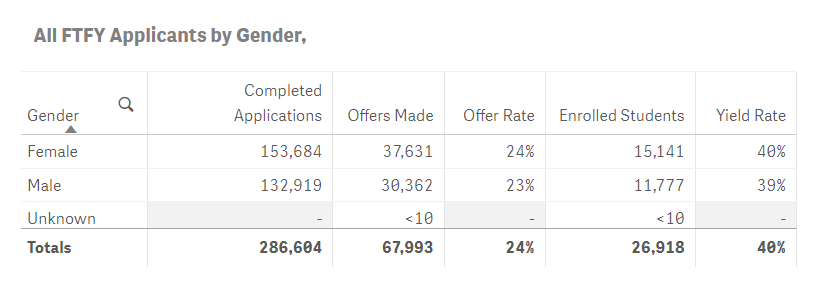
First-time, first-year applicants, offers and yields by gender, 2016-2021. Click for more legible image.
by James A. Bacon
As highlighted in our last post, the University of Virginia admits significantly more women than men. The split in the undergraduate student body is roughly 54/46. My aim in pointing out the disparity was not, as some readers presumed, to argue for special preferences for men; admission to UVa should be based on merit. I was exploring the question of whether the goal of achieving “equity” (whether defined as equal “outcomes” or equal “opportunity”) applies to all under-represented groups, including men, or just to so-called “marginalized” groups favored by progressive ideology.
Having documented that males are comparable to females in academic aptitude, at least among those who take the SATs, I suggested that some other factor might account for the disparity in their numbers at UVa. One possibility is that more women than men apply to UVa. All other things being equal, one would expect more women to be admitted if more women applied. Another possibility, which I raised in a previous post, is that UVa is suffused with subtle but systemic anti-male bias.
In this post, we’ll examine the role of the admissions process. I will delve into the issue of campus culture in a future post.
UVa publishes admissions statistics on its Institutional Research and Analysis website. The data seem clear: there is little discernible difference in the rate at which men and women were accepted (24% vs. 23%) between 2016 and 2021, and little discernible difference in the rate at which those who are accepted subsequently enrolled, a statistic referred to as “yield” (40% vs. 39%). If there was a bias in admissions, it does not appear to have been in the process for selecting applicants.
The statistic to focus on is the number of completed applications. Why do more women apply to UVa than men? Does the UVa admissions office sell itself more aggressively to women than men? Does UVa’s campus culture appeal more to women than to men? Do men feel less of a sense of “belonging” than women?
The unsatisfying answer is this: based on data made available to the public, we don’t know.
One issue I want to put to rest is the argument that female predominance in enrollment at UVa reflects the fact that women outnumber men in higher education generally. The national ratio is commonly said to be 60% to 40%. By that measure, the gender imbalance is less at UVa than it is nationally, so what’s the fuss? There is nothing unique about UVa, the argument goes. The gender imbalance stems from broad social trends beyond the control of any single institution.
But there’s a problem with this interpretation. UVa is not remotely representative of the entire college/community college population.
The Atlantic lays out a plausible explanation for the steadily widening gap between college enrollment among men and women at the national scale.
The sociologist Kathryn Edin has written that men without college degrees in deindustrialized America have been adrift for decades. They face the simultaneous shocks of lost jobs, disintegrating nuclear families, and rising deaths of despair in their communities. As 20th-century institutions have crumbled around them, these men have withdrawn from organized religion. Their marriage rates have fallen in lockstep with their church attendance. Far from the ordered progression of the mid-century American archetype—marriage, career, house and yard—men without college degrees are more likely to live what Edin and other researchers call “haphazard” lives, detached from family, faith, and work.
That explanation is entirely consistent with what I have observed of American society, and it might well explain why relative male college attendance is declining overall. But UVa does not draw extensively from the lumpenproletariat where social dysfunction is acute. It draws overwhelmingly from the upper-middle and professional classes that have largely kept families intact, that offer boys stable role models, that prosper in the knowledge economy, where males mostly stay out of jail, and among whom deaths of despair are a relative rarity.
As argued in the previous post on this topic, high-achieving high-school students are as likely to be male as female. High-achieving students of both genders are disproportionately likely to come from high-functioning social classes. UVa pulls from that pool of applicants.
The social breakdown alluded to by The Atlantic poses the greatest threat to colleges and universities that cater to students lower on the ladder of academic achievement, especially institutions that are geared to so-called “first time” students (meaning they are the first in their families to attend college). Those students are far more likely to come from dysfunctional families. And the colleges that admit them in large numbers are more likely to have lopsided female-to-male ratios.
Thus, at an institution such as Virginia Commonwealth University, which touts itself as a school for first-generation students, the female-to-male ratio is 64% to 36%. Similarly, the ratio at Norfolk State University, which caters to first-generation African-American students, is 67% to 33%.
There must be a different reason for the gender imbalance at UVa. In the next post, we’ll look at the evidence of anti-male bias.


